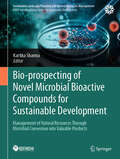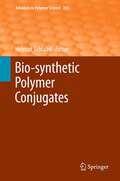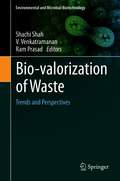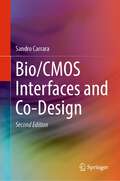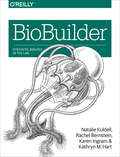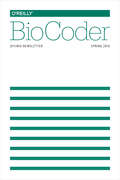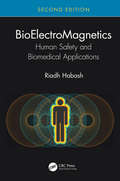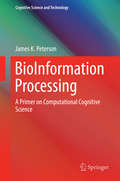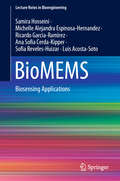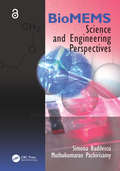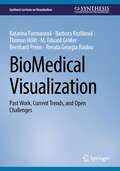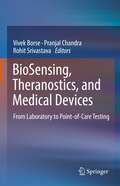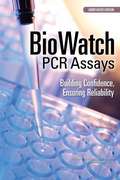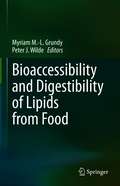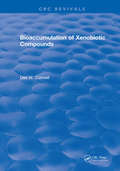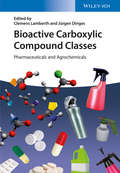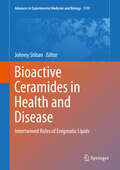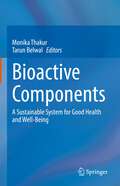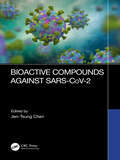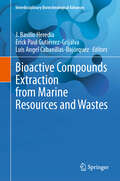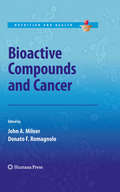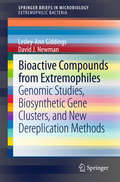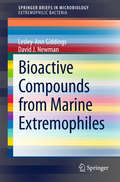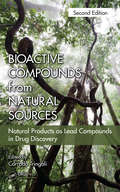- Table View
- List View
Bio-prospecting of Novel Microbial Bioactive Compounds for Sustainable Development: Management of Natural Resources Through Microbial Conversion into Valuable Products (Sustainable Landscape Planning and Natural Resources Management)
by Kartika SharmaThis book discusses current developments and upcoming trends in the microbial synthesis of various bioactive compounds from waste product which have a very good market worldwide. The extraction of biologically active compounds from microorganisms is still essential for the creation of novel pharmaceuticals and agricultural chemicals, and has underpinned their application as drugs and functional food ingredients. The demand of pharmaceuticals, nutraceuticals and agrochemicals is rising globally for the multi-billion dollar market of human disease prevention and treatment. However, the limitations and issues associated with the extraction of these bioactive compounds from natural resources, such as plants, animals, or fungi, limit the large-scale use of pharmaceuticals, nutraceuticals, and agrochemicals. The microbial production of agrochemicals, nutraceuticals, and pharmaceuticals by utilizing by utilizing waste product is now thought to be an environmentally benign process. The major goal of this book is to draw attention to excellent original research and review articles that contain cutting-edge characterization techniques and novel bioactive chemicals production that make important contributions to the field with many prospective applications. In this book, the potential for using microbial bioactive compounds which have positive health effects in their entirety is highlighted. This book is written by eminent scientists from around the world and seasoned researchers, thoroughly discusses current developments and patterns in the microbial synthesis of bioactive compounds. Academicians, scientists, researchers, graduate and post-graduate students who work in the highly dynamic and competitive fields of pharmaceuticals, nutraceuticals, and agrochemicals discovery will find this book to be ideal.
Bio-synthetic Polymer Conjugates (Advances in Polymer Science #253)
by Helmut SchlaadPolypeptide-Polymer Conjugates, by Henning Menzel Chemical Strategies for the Synthesis of Protein-Polymer Conjugates, by Björn Jung and Patrick Theato Glycopolymer Conjugates, by Ahmed M. Eissa and Neil R. Cameron DNA-Polymer Conjugates: From Synthesis, Through Complex Formation and Self-assembly to Applications, by Dawid Kedracki, Ilyès Safir, Nidhi Gour, Kien Xuan Ngo and Corinne Vebert-Nardin Synthesis of Terpene-Based Polymers, by Junpeng Zhao and Helmut Schlaad
Bio-valorization of Waste: Trends and Perspectives (Environmental and Microbial Biotechnology)
by Ram Prasad Shachi Shah V. VenkatramananThis book explores the concept and methods of waste management with a new approach of biological valorization. Waste valorization is a process that aims to reduce, reuse, and recycle the waste into usable, value-added, and environmental benign raw materials which can be a source of energy. The book brings together comprehensive information to assert that waste can be converted into a resource or a raw material for value addition. Waste valorization imbibes the natural recycling principles of zero waste, loop closing, and underlines the importance of sustainable and environmentally friendly alternatives. Drawing upon research and examples from around the world, the book is offering an up-to-date account, and insight into the contours of waste valorization principles, biovalorization technologies for diverse group of wastes including agricultural, municipal, and industrial waste. It further discusses the emerging paradigms of waste valorization, waste biorefineries, valorization technologies for energy, biofuel, and biochemical production. The book meets the growing global needs for a comprehensive and holistic outlook on waste management. It is of interest to teachers, researchers, scientists, capacity builders and policymakers. Also, the book serves as additional reading material for undergraduate and graduate students of biotechnology and environmental sciences.
Bio/CMOS Interfaces and Co-Design
by Sandro CarraraThis textbook demonstrates new paradigms for the interface between CMOS circuits and the biological world. A deep theoretical description of such an interface is defined and discussed, while various real applications are demonstrated by also discussing several analog CMOS circuits. Electrochemical techniques are proposed in detail to learn how to design integrated biosensors. Biological materials are described to provide devices selectivity. Nanoscale materials are discussed to provide device sensitivity. CMOS circuits are analyzed to provide real applications. Extensive examples with solutions are provided, as well as exercises at the end of each chapter. This book introduces students to the state-of-the-art in Bio/CMOS interfaces, describing leading-edge research in CMOS design and VLSI development for applications requiring intimate integration of biological molecules onto the chip. It provides multidisciplinary content ranging from biochemistry to CMOS design in order to address Bio/CMOS interface co-design in biosensing applications.
BioBuilder: Synthetic Biology in the Lab
by Natalie Kuldell Karen Ingram Kathryn M Hart Rachel BernsteinToday’s synthetic biologists are in the early stages of engineering living cells to help treat diseases, sense toxic compounds in the environment, and produce valuable drugs. With this manual, you can be part of it. Based on the BioBuilder curriculum, this valuable book provides open-access, modular, hands-on lessons in synthetic biology for secondary and post-secondary classrooms and laboratories. It also serves as an introduction to the field for science and engineering enthusiasts.Developed at MIT in collaboration with award-winning high school teachers, BioBuilder teaches the foundational ideas of the emerging synthetic biology field, as well as key aspects of biological engineering that researchers are exploring in labs throughout the world. These lessons will empower teachers and students to explore and be part of solving persistent real-world challenges.Learn the fundamentals of biodesign and DNA engineeringExplore important ethical issues raised by examples of synthetic biologyInvestigate the BioBuilder labs that probe the design-build-test cycleTest synthetic living systems designed and built by engineersMeasure several variants of an enzyme-generating genetic circuitModel "bacterial photography" that changes a strain’s light sensitivityBuild living systems to produce purple or green pigmentOptimize baker’s yeast to produce ?-carotene
BioCoder #7: Spring 2015 (DIY/BIO Newsletter #7)
by Inc. O'Reilly MediaBioCoder is a quarterly newsletter for DIYbio, synthetic bio, and anything related. You’ll discover:Articles about interesting projects and experiments, such as the glowing plantArticles about tools, both those you buy and those you buildVisits to DIYbio laboratoriesProfiles of key people in the communityAnnouncements of events and other items of interestSafety pointers and tips about good laboratory practiceAnything that’s interesting or useful: you tell us!And BioCoder is free (for the time being), unless you want a dead-tree version. We’d like BioCoder to become self supporting (maybe even profitable), but we’ll worry about that after we’ve got a few issues under our belt.If you’d like to contribute, send email to BioCoder@oreilly.com. Tell us what you’d like to do, and we’ll get you started.
BioCoder #8: July 2015
by Inc. O'Reilly MediaBioCoder is a quarterly newsletter for DIYbio, synthetic bio, and anything related. You’ll discover:Articles about interesting projects and experiments, such as the glowing plantArticles about tools, both those you buy and those you buildVisits to DIYbio laboratoriesProfiles of key people in the communityAnnouncements of events and other items of interestSafety pointers and tips about good laboratory practiceAnything that’s interesting or useful: you tell us!And BioCoder is free (for the time being), unless you want a dead-tree version. We’d like BioCoder to become self supporting (maybe even profitable), but we’ll worry about that after we’ve got a few issues under our belt.If you’d like to contribute, send email to BioCoder@oreilly.com. Tell us what you’d like to do, and we’ll get you started.
BioElectroMagnetics: Human Safety and Biomedical Applications
by Riadh HabashThis book is an educational resource of evolving scientific knowledge in the area of bioelectromagnetics that may serve the interests of students and decision-makers, as well as society as a whole. It is distinguished by extensive descriptions of fundamental biophysical concepts and their relevance to human health. Reflecting the transdisciplinary approach from several different intellectual streams including physics, biology, epidemiology, medicine, environment, risk science, and engineering, the book is quite a venture into the battling studies to assess the latest research on health effects and biomedical applications of EM energy. This new edition of the book particularly looks at the potential threats from the emerging 5G wireless networks, which will deploy large numbers of low-powered smartphones, notebooks, tablets, radio access networks, and other transmitters. Features Introduces necessary biophysical principles of EM fields in the context of their interaction with living systems. Strengthens understanding of cutting-edge research on several major areas in the broad area of bioelectromagnetics. Presents safety standards and guidelines for human exposure to EM fields. Discusses techniques that have been developed to ensure adequate EM-thermal dosimetry required for both health effects and biomedical applications. Provides insight into the determinants of EM health risk assessment and public concerns. Includes extensive reference list at the end of each chapter to enhance further study. Riadh Habash is a special appointment professor and McLaughlin Research Chair in Electromagnetic Fields and Health at the University of Ottawa, Canada. He has been the recipient of many awards, including the National Wighton Fellowship Award, and has authored or co-authored over 90 research articles, six books, and five book chapters. His most recent books are Green Engineering in 2017 and Professional Practice in 2019 (CRC Press), with the remaining previous books targeting the area of bioelectromagnetics.
BioInformation Processing: A Primer on Computational Cognitive Science (Cognitive Science and Technology)
by James K. PetersonThis book shows how mathematics, computer science and science can be usefully and seamlessly intertwined. It begins with a general model of cognitive processes in a network of computational nodes, such as neurons, using a variety of tools from mathematics, computational science and neurobiology. It then moves on to solve the diffusion model from a low-level random walk point of view. It also demonstrates how this idea can be used in a new approach to solving the cable equation, in order to better understand the neural computation approximations. It introduces specialized data for emotional content, which allows a brain model to be built using MatLab tools, and also highlights a simple model of cognitive dysfunction.
BioMEMS: Biosensing Applications (Lecture Notes in Bioengineering)
by Samira Hosseini Michelle Alejandra Espinosa-Hernandez Ricardo Garcia-Ramirez Ana Sofia Cerda-Kipper Sofia Reveles-Huizar Luis Acosta-SotoThis book highlights the latest advances in bioMEMS for biosensing applications. It comprehensively reviews different detection methods, including colorimetric, fluorescence, luminescence, bioluminescence, chemiluminescence, biochemiluminescence, and electrochemiluminescence, and presents various bioMEMS for each, together with recent examples. The book also offers an overview of the history of BioMEMS and the design and manufacture of the first bioMEMS-based devices.
BioMEMS: Science and Engineering Perspectives
by Simona Badilescu Muthukumaran PackirisamyAs technological advancements widen the scope of applications for biomicroelectromechanical systems (BioMEMS or biomicrosystems), the field continues to have an impact on many aspects of life science operations and functionalities. Because BioMEMS research and development require the input of experts who use different technical languages and come f
BioMedical Visualization: Past Work, Current Trends, and Open Challenges (Synthesis Lectures on Visualization)
by Bernhard Preim Katarína Furmanová Barbora Kozlíková Thomas Höllt M. Eduard Gröller Renata Georgia RaidouThis book provides an overview of the many visualization strategies that have been proposed in recent decades for solving problems within the disciplines of medicine and biology. It also evaluates which visualization techniques applied to various areas of biomedicine have been the most impactful and which challenges can be considered solved using visualization. The topics covered in this book include visualization research in omics, interaction networks and pathways, biological structures, tumor diagnosis and treatment, vasculature, brain, surgery, educational contexts, therapy and rehabilitation, electronic health records, and public health. One chapter is dedicated to general visualization techniques commonly used for biomedical data, such as surface and volume rendering, as well as abstract and illustrative approaches. For each of these areas, the past and present research trends are discussed, highlighting the influential works. Furthermore, the book explains how research is affected by developments in technology, data availability, and domain practice. Individual sections also summarize the typical target users, the nature of the data, and the typical tasks addressed in the given domain. With a uniquely broad scope, the book identifies research trends in biomedical visualization using a manually curated and searchable repository of more than 3,800 publications. The resultant trends are further categorized according to the application field and using natural language processing. The book also utilizes 16 interviews conducted with researchers in the field of biomedical visualization for the purpose of soliciting their opinions regarding the evolution and trends in the domain. The book handles these topics in a concise manner to help readers orient themselves in the already mature and diverse field of biomedical visualization without overwhelming them with technical details. As such, the book can help young researchers to become familiar with past challenges and identify future ones. For more senior researchers, it can serve as an insightful overview of the research field and the direction in which it is heading.
BioSensing, Theranostics, and Medical Devices: From Laboratory to Point-of-Care Testing
by Rohit Srivastava Pranjal Chandra Vivek BorseThis book provides up-to-date information on the prototypes used to develop medical devices and explains the principles of biosensing and theranostics. It also discusses the development of biosensor and application-orientated design of medical devices. In addition to summarizing the clinical validation of the developed techniques and devices and the regulatory steps involved in their commercialization, the book highlights the latest research and translational technologies toward the development of point-of-care devices in the health care. Lastly, it explores the current opportunities, challenges and provides troubleshooting on the use of biosensors in precision medicine. The book is helpful for researchers and medical professionals working in the field of clinical theranostics, and medical-device development wanting to gain a better understanding into the principles and processes involved in the development of biosensors.
BioWatch PCR Assays: Building Confidence, Ensuring Reliability; Abbreviated Version
by Committee on PCR Standards for the BioWatch ProgramBioWatch is an air monitoring system deployed in jurisdictions around the country with the goal of detecting the presence of certain high risk pathogenic microorganisms. It relies on a network of federal and nonfederal collaborative relationships to be successful, and is one part of a larger array of disease surveillance, intelligence-gathering, and biomonitoring activities in support of public safety and health. The assays used in the BioWatch system to detect the presence of pathogens in collected samples rely on the technique of polymerase chain reaction (PCR) to sensitively and specifically amplify target nucleic acid sequences. "BioWatch PCR Assays" evaluates and provides guidance on appropriate standards for the validation and verification of PCR tests and assays in order to ensure that adequate performance data are available to public health and other key decision makers with a sufficient confidence level to facilitate the public health response to a BioWatch Actionable Response. This report discusses principles of performance standards, reviews information from several existing guidance documents and standards that might be applicable to BioWatch, and discusses assay testing efforts that have occurred or are ongoing. BioWatch PCR Assays provides recommendations on general principles and approaches for a performance standard and validation framework to meet BioWatch's mission. The report also considers how developments in technology, particularly in multiplex PCR and next-generation sequencing, can contribute to the ability of the BioWatch program to meet current and future challenges. This report has been determined to contain information exempt from disclosure under 5 U. S. C. 552(b). Section 15 of the Federal Advisory Committee Act provides that the National Academies shall make its final report available to the public unless the National Academies determines that the report would disclose matters described in one or more of the exemption provisions under the Freedom of Information Act (FOIA). In such case, the National Academies "shall make public an abbreviated version of the report that does not disclose those matters. " This unrestricted, abbreviated version of the report represents, in so far as possible, the committee's findings, recommendations, and other substantive material without disclosing materials described in 5 U. S. C. 552(b).
Bioaccessibility and Digestibility of Lipids from Food
by Myriam M.-L. Grundy Peter J. WildeThe structure of a food influences the way it is transformed during processing and digestion. This in turn has an impact on nutrient bioaccessibility (release) and digestibility, and subsequently on the physiological response and health of the individual who consumes that food. Although evidence exists on the health benefits associated with the inclusion of certain lipid-rich foods (e.g. nuts, dairy products and fish) in the diet, the mechanisms that explain the physiological effects and the long-term benefits are not well understood. Lipids in themselves have many beneficial health effects: they are a source of energy and essential fatty acids, they are structural components of cell membranes, they are required to solubilise fat soluble compounds, and they serve as precursors of hormones. In addition, the overall structure of the food containing the lipids plays a crucial role in determining health benefits, notably by influencing lipid bioaccessibility and digestibility. Bioaccessibility and digestibility of lipids from food uniquely focuses on the physico-chemical properties of lipids and lipid rich food, as well as the subsequent effects on human health. Chapters from experts in food digestion examine food structure at both the macro- and micro- levels, covering lipids from plant and animal food products. The editors have developed the book for dietitians, nutritionists, and food scientists. Clinicians and other health professionals, educators in nutrition, and others working in the food industry will also find the material relevant.
Bioaccumulation of Xenobiotic Compounds
by Des W. ConnellOne of the very few - if not only - books written exclusively related to this topic. This book comprehensively outlines the principles governing the accumulation of chemicals from the environment by organisms. Packed with tables and diagrams, this work reviews the experimental data available on both terrestrial and aquatic systems. It describes methods which are used to predict bioaccumulation of chemicals from their physicochemical properties. It also reviews environmental and other factors influencing bioaccumulation. This text also includes previously unpublished theoretical explanations of several bioaccumulation processes, including food chain biomagnification. Information in this exceptional volume is useful to government officials involved with environmental management, chemists, biologists, consultants working with chemical waste control, researchers, and graduate students.
Bioactive Carboxylic Compound Classes: Pharmaceuticals and Agrochemicals
by Jürgen Dinges Clemens LamberthFollowing the successful and proven concept used in "Bioactive Heterocyclic Compound Classes" by the same editors, this book is the first to present approved pharmaceutical and agrochemical compounds classified by their carboxylic acid functionality in one handy volume. Each of the around 40 chapters describes one or two typical syntheses of a specific compound class and provides concise information on the history of development, mode of action, biological activity and field of application, as well as structure-activity relationships. In addition, similarities and differences between pharmaceuticals and agrochemicals are discussed in the introduction. Written by a team of experts in the field, this is a useful reference for researchers in academia and chemical or pharmaceutical companies working in the field of total synthesis and natural product chemistry, drug development, and crop protection research.
Bioactive Ceramides in Health and Disease: Intertwined Roles of Enigmatic Lipids (Advances in Experimental Medicine and Biology #1159)
by Johnny StibanThis book is about the various roles of bioactive ceramides and other sphingolipids in cellular biology. The enigmatic biophysical and biochemical properties of ceramides and their propensity to influence membranes whether as rafts or protein-permeable channels are heavily discussed. Metabolism of ceramides and their metabolites is also focused with ceramide synthase family of proteins being a target of extensive review. Ceramide 1-phosphate and other sphingolipids are also presented in cellular physiology and pathophysiology. Prokaryotic origins of mitochondria at the level of membranes and the occurrence of apoptosis in bacteria are presented. Many aspects of ceramide and sphingolipid biology are addressed in this book. Its focus is the metabolism of ceramide in normal and diseased states and the biophysical and biochemical mechanisms governing the bioactivity of these molecules. Sphingolipid research has surged over the past thirty years and this book gathers the recent findings of various aspects of sphingolipid biochemistry. World-renowned scientists from the field of lipid biology, specifically sphingolipid biochemistry, were gathered to write this book. Scholars from most continents of the globe committed to write diligently about their expertise and the newest findings in the relevant fields. This book came to fruition after almost a year and a half of laborious preparation and diligent writings. This book is targeted to the experienced reader who is looking to read about the various aspects of bioactive ceramide signaling, as well as to the newcomer into the field, as the topics are explained in concise yet very informative manner. The authors and editor wish all readers a pleasant time reading this volume, and are adamant that this book will meet all expectations.
Bioactive Components: A Sustainable System for Good Health and Well-Being
by Monika Thakur Tarun BelwalThis book compiles updated information about the role and health benefits of various bioactives in food. Different chapters are contributed by academicians, food scientists, technologists, and medical practitioners. The book addresses both theoretical and applied aspects of bioactive components and provides exhaustive knowledge about bioactive components. It comprises 27 chapters organized into 4 major sections covering topics in food science and technology, functional foods, and nutraceuticals. It provides perspectives for innovation, sources, applications, and sustainability in bioactive component research. The first section starts with introduction of bioactive components consisting of seven different chapters primarily focusing on the bioactive components and their sources with respective health benefits. The second section, comprising five different chapters, deals with different technological trends, regulations, and safety aspects of bioactive components. With eight chapters, the third section covers the role of bioactive components in human health and the role of functional foods in combating various health-related issues. The fourth section reviews functional foods through six chapters that cover the use of bioactive components in various food products. The book will prove useful to advanced food technology graduate and undergraduate students and research scholars, practicing food technologists in food and related industries, entrepreneurs, food-pharma researchers, and other scientists seeking information about smart and sustainable processes as well as information needed to design and develop these processes.
Bioactive Compounds Against SARS-CoV-2
by Jen-Tsung ChenCoronaviruses can cause illness, severe disease, and death; for example, Middle East respiratory syndrome (MERS), severe acute respiratory syndrome (SARS), and COVID-19. Vaccine development and antiviral drugs are challenged by the propensity for viral mutations allowing these viruses to evade such therapies. There are a number of bioactive compounds from natural sources, which can exert health benefits and act as antiviral therapies such as anti-inflammation, antioxidative stress, and immune regulation. This book summarizes research on the potential efficacy and underlying mechanisms of bioactive compounds and traditional medicines against SARS-CoV-2. Key Features Summarizes the potential benefits of bioactive therapies for coronaviruses Focuses on COVID-19, but also covers MERS and SARS Provides alternatives to vaccines and other antiviral drugs whose efficacy is reduced by viral mutations Relevant for clinicians and public health officials
Bioactive Compounds Extraction from Marine Resources and Wastes (Interdisciplinary Biotechnological Advances)
by J. Basilio Heredia Erick Paul Gutiérrez-Grijalva Luis Angel Cabanillas-BojórquezThis book provides information about the principal biotechnological strategies (enzyme-assisted extraction, liquid fermentation, and solid-state fermentation) used for the bioactive compounds (bioactive peptides, carotenoids, phenolic acids, polyunsaturated fatty acids, vitamins, and minerals, among others) extraction from the marine resource (marine animals, microalgae, seaweed, among others) and wastes (crustaceans, fish, and others). This book also highlights the importance of bioactive compounds in marine resources and wastes and the perspectives for a potential industrial application. This book is oriented to researchers related to marine resources and marine wastes, who apply their knowledge in the innovation of the extraction and application of bioactive compounds from these sources. Moreover, this book will also provide knowledge and areas of opportunity for entrepreneurs, different industries, and the development of new products that could be used in the overall improvement of different areas such as human health.
Bioactive Compounds and Cancer (Nutrition and Health)
by John A. Milner Donato F. RomagnoloBecause of the wealth of new information generated by the scientific community during the last decade on the role of nutrition on cancer risk, this book provides a forum for presentation and discussion of recent scientific data and highlights a set of dietary recommendations. Bioactive Compounds and Cancer presents chapters that highlight laboratory and clinical findings on how selected nutrients function as signaling molecules and, as such, influence cellular behavior and cancer predisposition. This important compendium focuses on understanding the role of nutrition in cancer biology, the molecular action of bioactive food components and xenobiotics on cancer risk, the role of dietary components in cancer prevention and/or treatment, and nutrition education with the most up to date dietary recommendations that may reduce cancer risk. This volume will be of interest to specialized health professionals, clinicians, nurses, basic and clinical researchers, graduate students, and health officials of public and private organizations.
Bioactive Compounds from Extremophiles: Genomic Studies, Biosynthetic Gene Clusters, and New Dereplication Methods (SpringerBriefs in Microbiology)
by Lesley-Ann Giddings David J. NewmanThis SpringerBrief sheds new light on bioactive materials from extremophiles with the focus on the biosynthesis processes and related genomics. It deals with all aspects of the chemical compounds produced by organisms living under extreme conditions that may have potential as drugs or lead to novel drugs for human use.
Bioactive Compounds from Marine Extremophiles (SpringerBriefs in Microbiology)
by Lesley-Ann Giddings David J. NewmanThis SpringerBrief sheds new light on bioactive materials from marine extremophiles. It deals with all aspects of the chemical compounds produced by organisms living under extreme conditions that may have potential as drugs or lead to novel drugs for human use.
Bioactive Compounds from Natural Sources: Natural Products as Lead Compounds in Drug Discovery
by Corrado TringaliThe first edition of Bioactive Compounds from Natural Sources was published in a period of renewed attention to biologically active compounds of natural origin. This trend has continued and intensified-natural products are again under the spotlight, in particular for their possible pharmacological applications. Largely focusing on natural products
